Praying Mantis Facts | Read about this Astonishing Insect
If there was a competition for the coolest insect name, Praying Mantis would win it! Praying Mantis actually refers to an order of insects. There are over 2400 different species and 460 generas of Praying Mantises worldwide!

Wondering how they got their name? Mantises have prominent front legs for catching prey. They usually stand in an upright pose, with their forearms folded. This makes it look like they’re deep in prayer!
Quick Praying Mantis Facts
- Praying mantises are the only insects that possess stereo vision.
- The praying mantises have a subpar hearing ability.
- In warmer climates, praying mantis habitat is more prevalent.
- The praying mantises calmly pursue or wait for their prey to approach,
- Praying mantises are related to termites and cockroaches
- Sometimes, female mantids eat their mates.
- Praying mantises’ distinctive appearances can act as camouflage for defense.
- The body of the flower mantis resembles flowers.
- Praying mantises are preyed upon by predators such as spiders, frogs, lizards, and birds.
- Praying mantises catch prey with specialized front legs.
Praying Mantis Appearance
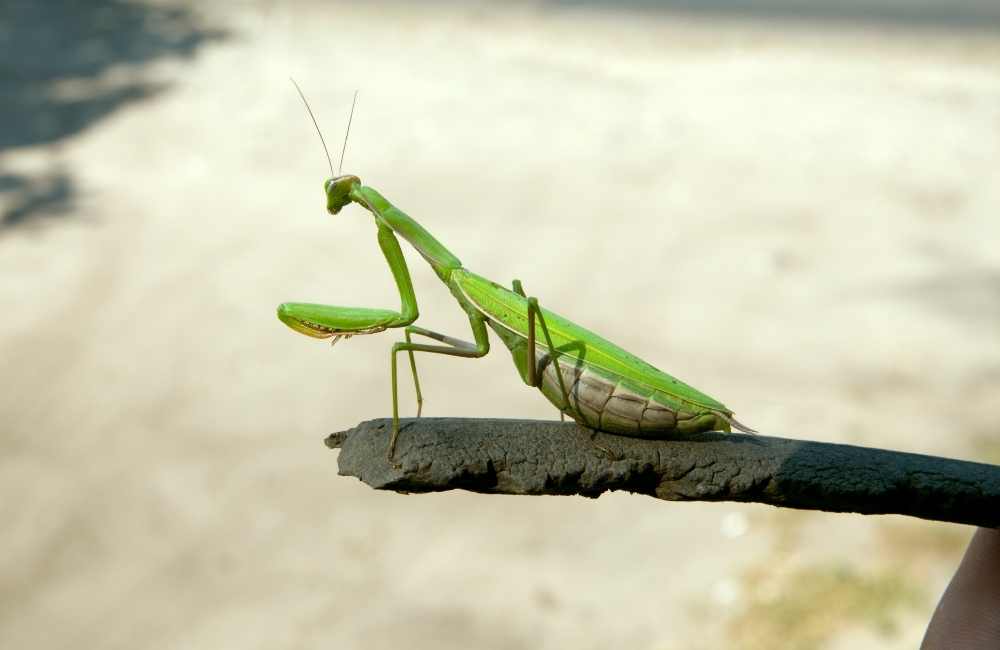
Mantises have large triangle-shaped heads. They have long necks. They have 2 large compound eyes and 3 smaller ones. They also have a pair of antennae. Praying Mantises are usually green or brown in color.
How big are Praying Mantis?
Since there are so many species of Praying Mantises, their sizes also vary. On average, they have a length of 2 inches and weigh 0.009 pounds. The smallest species of Mantises is Bolbe pygmaea, found only in Australia. It has an average length of only 0.39 inches! Another species from Australia, Archimantis monstrosa or the Monster Mantis, can grow up to 3.5 inches!
You can check out our article on Grasshopper facts for kids.
Largest Praying Mantis
The Chinese Mantis, Tenodera sinensis, is one of the largest species of Praying Mantises. They can grow as long as 5 inches! The largest specimen was recorded in 1929, with a length of over 7 inches!
The largest known species of Mantises is Leptocola phthisica. It is a big stick mantis from East Africa. Individuals have been known to reach a whopping length of over 10 inches!
What do Praying Mantis eat?
Praying Mantises are carnivores. They eat many insects and even small animals. Their diet mainly includes crickets and grasshoppers. They also like ants, caterpillars, moths, flies, and beetles. They occasionally feed on vertebrates like lizards, frogs, small fishes, and birds!
Larger Mantises can also eat smaller ones. Chinese Mantis sometimes feed on pollen too! Mantises only feed on live prey. They never eat dead remains. They usually wait for the prey to come within their reach, although a few species may hunt when they’re really hungry.
Do Praying Mantis eat spiders?
Praying Mantises are known to catch and eat live spiders. They grab spiders from their rear end before eating them with their powerful mouths. This is to protect themselves from harmful venom sacs. Mostly, they eat only non-venomous spiders that are small in size.
Why do female Mantises eat the male?
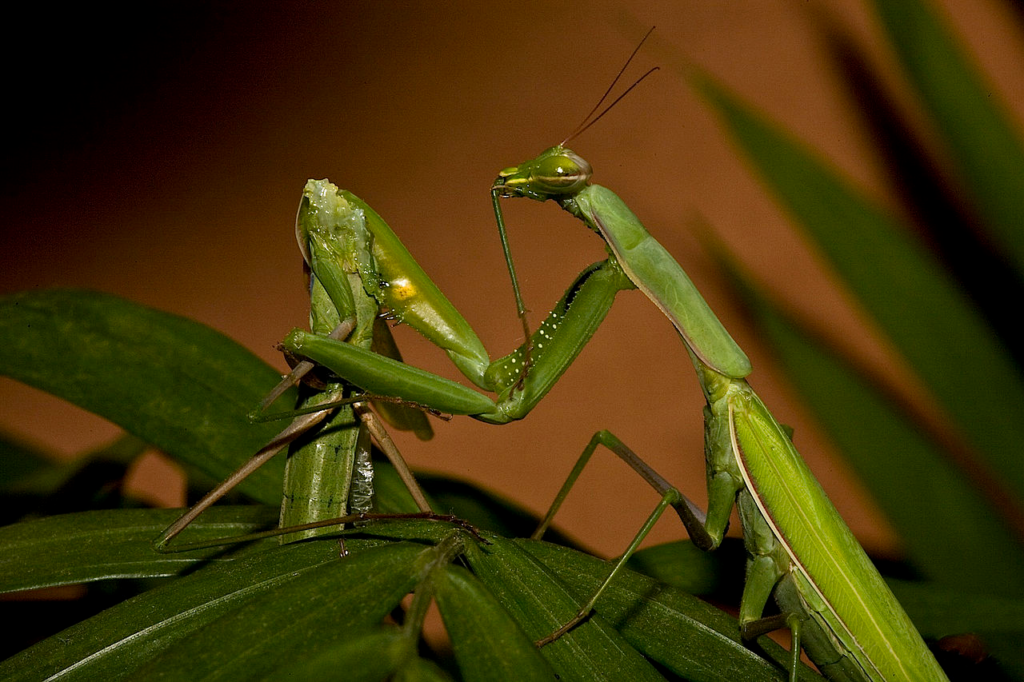
Almost 90% of predatory Mantis species practice a ritual called sexual cannibalism. During mating, the female Mantis will often bite off and eat the male’s head! This usually happens when the male is dismounting the female.
There is no concrete reason for why Mantises do this. Some believe this helps the female get sustenance during the mating process, which can be very energy-intensive. This is because well-fed females seem to eat the males less than hungry ones.
Some scientists also think the amino acids that females receive on eating the males help them lay more eggs. One train of thought also believes that sexual cannibalism is only practiced by Mantises who are under observation. Thus, it might just be a stress response.
Where are Praying Mantis found?
Praying Mantises are found on every continent of the world except Antarctica! They are mostly found in tropical and subtropical regions. They thrive in areas with mild winters and sufficient vegetation. This includes rainforests, grasslands, meadows, and even deserts.
How long do Praying Mantis live?
In the wild, Praying Mantises have an average lifespan of only 1 year. Thus they are short-lived. Males have a shorter life expectancy of 7 to 8 months, compared to 11 to 12 months for females. Smaller species only live 4 to 6 weeks.
Praying Mantis Physical Traits
Praying Mantis Eyes and Vision
A Praying Mantis has a total of 5 eyes. These include 2 large, forward-facing compound eyes on both sides and 3 simple eyes in the middle of its head.
The big eyes are used for detecting motion and distance. The smaller eyes are used for detecting light. The front portion of the big eyes is called a fovea. It is a collection of many cells that help them see. It lets them focus and track prey efficiently.
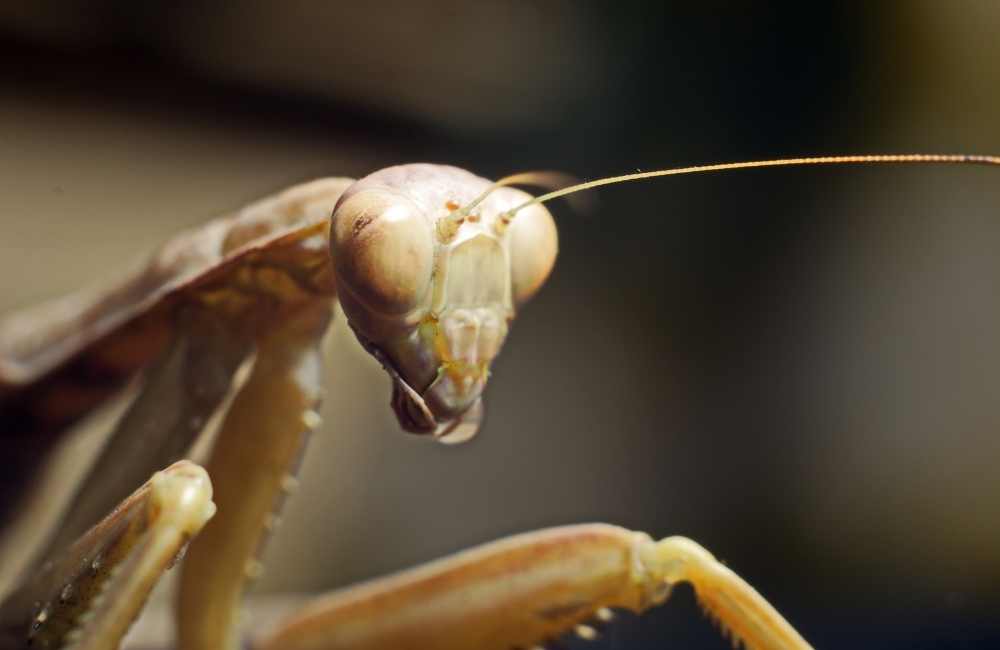
The compound eyes are widely spaced. This affords the Mantises a wide field of vision. They also have a stereo vision or 3D vision. What does this mean? Just like humans, Mantises can also sense depth. The two eyes provide slightly different images of the same objects. Using this, their brain can tell how far and deep the object actually is.
Head Turners
The long necks of Mantises are highly flexible. Some species of Mantises can rotate it a full 180 degrees! When they notice a moving object, they will immediately turn their head to bring it into the direct field of view. This helps them quickly distinguish between prey and predators.
Praying Mantis Wings
Mantises fall under 3 categories. They are either long-winged, short-winged, or wingless. In the winged species, there are 2 sets of wings present. The outer wings act as a shield for the inner ones and also help the Mantis camouflage. The inner wings are clearer and delicate.
Do Praying Mantis fly?
Even in species that are not wingless, wings mostly develop very late in life. Many Mantises are thus completely flightless. The only time Mantises do fly is during mating season when females attract males. The males usually fly at night only to prevent being seen by predators.
Highly agile
Praying Mantises are very jumpy! They are extremely good at controlling their body. They use their front and hind legs to maintain balance while in the air. A leap takes less than one-tenth of a second! They can also change directions mid-air to jump on a specific target.
Talented at Camouflage
Mantises are masters of camouflage! This helps them escape predators and attract prey at the same time. Mantises found in grasslands and forests are usually green or lime, while those in drier regions are brown-colored.
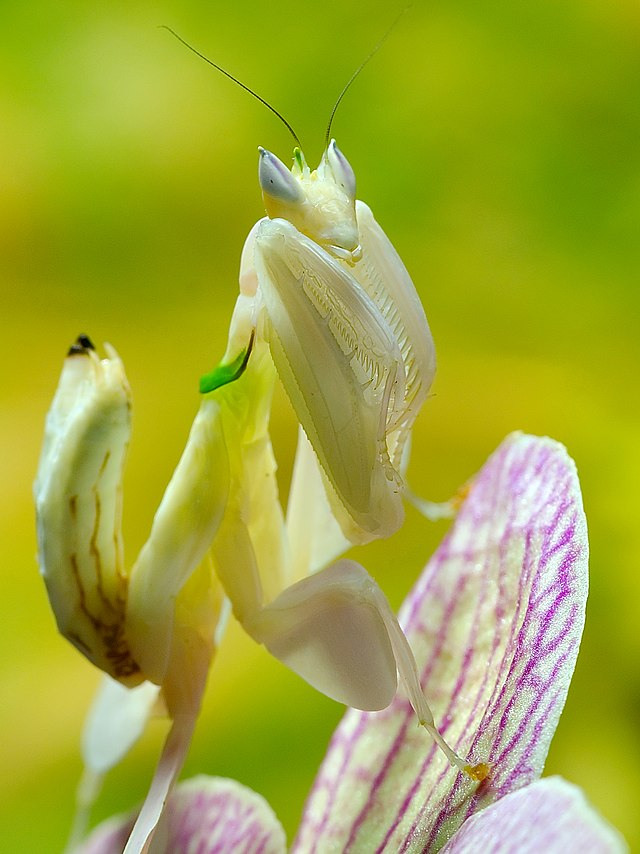
Some Mantis species resemble leaves, twigs, and stems to avoid detection. Orchid Mantises are a collection of species that resemble flowers! This lures prey which comes to collect pollen and nectar.
Praying Mantises can change their colors after molting to adapt to changing surroundings. Molting refers to an insect shedding its skin. Some species in Africa and Australia turn black just before the dry forest season ends. This lets them blend in with the environment when bushfires char the surroundings.
Hunting Adaptations
Praying Mantises are visual hunters and locate their prey by sight. They are ambush predators. They usually wait for prey to come near them before attacking. Mantises also have spikes on their front legs. They use these spikes to skewer and pin their prey in place.
They can move their limbs with lightning-fast speed to catch prey. They’re so quick, it’s tough to see with the naked eye! They eat their prey headfirst to prevent it from escaping.
Praying Mantis Life Cycle and Breeding
Mantises usually mate during autumn in temperate areas. A male typically mates only once in his lifetime. Mostly, they are either cannibalized by the female or die soon after mating.
Females can lay 10 to 400 eggs at once. These eggs are present inside a hardened protective cover. This egg mass is called an ootheca. The ootheca is attached to a plant or buried in the ground. Sometimes the mother guards it against predators.
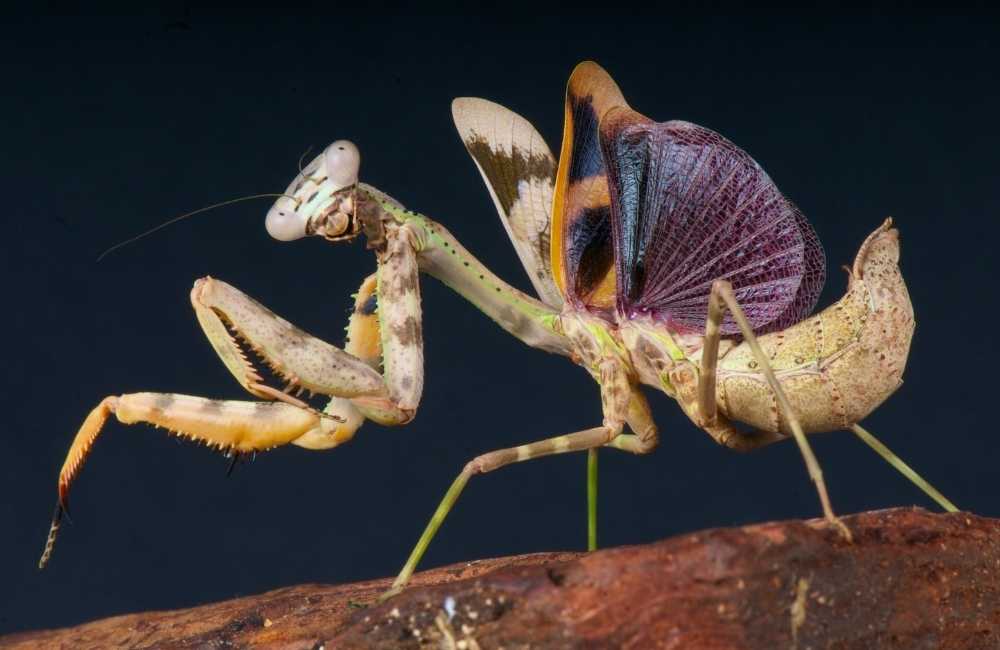
The eggs hatch after 3 to 6 weeks. Baby Mantises, called nymphs, emerge around springtime. These nymphs sometimes look like ants since many predators don’t like to eat them. The nymph molts 5 to 10 times before becoming an adult. After the final molt, most species develop wings.
Praying Mantis Scientific Name and Classification
Mantises belong to the family Mantodea. Of the 2400 or so species of Mantises, the European Mantis has the scientific name Mantis religiosa, which literally means Praying Mantis. Mantises are confused with grasshoppers or stick insects. But their closest relatives are actually termites and cockroaches!
Can you keep a Praying Mantis as a pet?
Mantises are actually very common pets. Since their lifespans are short, they are often bred in captivity. They are easy to care for and feed as well. They are also kept as pets by farmers since they provide efficient pest control.
How to care for a Praying Mantis?
Depending on the species, Praying Mantises should be housed in individual small tanks. Their diet should be varied. Nymphs and small Mantises can be fed fruit flies, while larger ones should be fed moths, house flies, and crickets.
The feed should be healthy and alive to prevent Mantises from catching a disease. Most Mantises get water off of plants. Thus, adequate vegetation should be provided in the tanks. Plants should be regularly misted.
Do Praying Mantis bite?
Praying Mantises are usually docile pets and don’t bite humans. They also aren’t venomous, so bites don’t have any harmful effects. Still, they should be handled and fed with caution.
Praying Mantis predators?
Major predators of Praying Mantis are wasps, hornets, ants, frogs, bats, monkeys, larger birds, spiders, and snakes. Sometimes, larger Mantises also feed on smaller and younger Mantises.
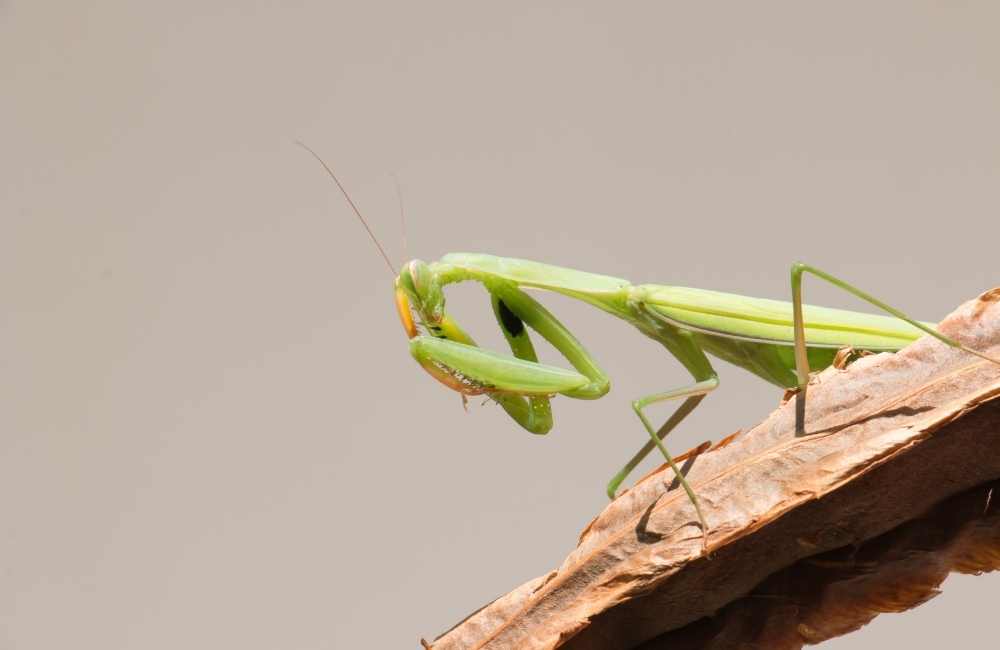
Praying Mantis superstition
Mantises were thought to possess supernatural powers in ancient civilizations like ancient Greece, Egypt, and Mesopotamia. Cultures like China associate them with meditation and calmness.
Because of their praying stance, they are regarded as spiritual creatures in many cultures like Christianity and Islam. While in Japan, they are considered bad omens of impending death! Spooky!
Amazing Facts about Praying Mantis
- Mantis comes from the Greek word ‘mantikos,’ meaning prophets!
- Most Mantises don’t have any ears, while some have just one on their belly!
- Mantises with an ear are very good at detecting sounds made by predatory bats!
- Praying Mantis are the only insects with a unique stereo vision!
- Scientists are studying Mantises to make small, fast robots with good vision!
